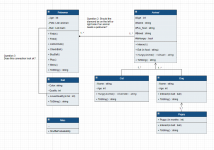So this is my class diagram. Is there anything that can be improved right away?
Some questions:
1. The backing fields, should they be in camelCase or Pascal?
2. The usage of the diamond arrow seen in the picture is tricky. Is there any rule of thumb to remember? Should the diamond go to the left or right? Also, the usage of the filled diamond arrow means that Animal needs to have a petowner right?
3. Is the connection between Petowner and Ball the way to go? Or shouldn't it be a connection at all between those?
Some questions:
1. The backing fields, should they be in camelCase or Pascal?
2. The usage of the diamond arrow seen in the picture is tricky. Is there any rule of thumb to remember? Should the diamond go to the left or right? Also, the usage of the filled diamond arrow means that Animal needs to have a petowner right?
3. Is the connection between Petowner and Ball the way to go? Or shouldn't it be a connection at all between those?

